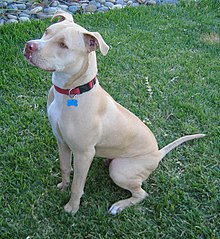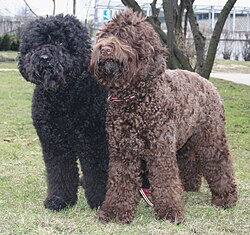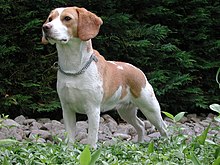Description
The Barbet is a rare breed. Most Barbet, especially those shown in
conformation shows, are entirely black, black and white, or brown. It is common to see white chest spots and white paws or legs on black or brown coated dogs. Parti, Creme, and Pied variations are being born but in very limited numbers.
Male Barbet usually grow to be about 21-25 inches (52 cm to 65 cm) tall, and they weigh between 40 and 60 pounds (18 kg to 27 kg), while the females usually grow to be about 20 to 23 inches (50 cm to 53 cm) tall, and they weigh between 30 and 50 pounds (13.5 kg to 23 kg).
Appearance
The breed stands 58 to 65 cms (20.5-25.5 inches) for the males in height, 52 to 61 for the females with a tolerance of 1 cm +/- and weighs 17 to 28 kg (35-60 pounds). The Barbet is a prototypic
water dog, with a long, woolly, and curly coat. Their coats grow long and must be groomed regularly, otherwise the coat can become matted and the barbet may lose small tufts of hair like tumbleweeds.
The accepted colours of the breed are solid black, brown, fawn, grey, pale fawn, white, or more or less pied. All shades of red-fawn and pale fawn are permitted. The shade should, preferably, be the same as the colour of the body. Grey and white are extremely rare; mixed colours (except with white) are considered as a fault. The most common colors are black or brown with white markings. The birth figures worldwide for 2007 are 176. All born were black or brown some with white markings on the chest, chin, and legs.
temperament
The Barbet’s personality is described as companionable, joyful, goofy, obedient, and intelligent. They are quick to learn and need lifelong obedience training. They are a great with children, families, and the elderly. Barbet will bond with their family and prefer to be in the same room with the family at all times. They need exercise daily to keep the dog in a healthy state of mind and body.
They are capable retrievers for
waterfowl hunting. In France the Barbet can take the Test d`Apptitude Naturelle (T.A.N.) a basic water retrieving test and has recently been permitted to participate in the BCE. (Brevet de Chasse a l'Eau) which is a general hunting test involving field and water trials. In Germany the Barbet takes part in field trials.
Genetic Diseases
As with all purebred dogs, Barbet are vulnerable to certain genetic defects. Due to the limited gene pool for this breed, conscientious breeders carefully study pedigrees and select dogs to minimize the chance of genetic diseases. Unfortunately, like many breeds, a growing popularity has encouraged breeding by people who are not knowledgeable about the breed. Of the few health issues that have exhibited themselves, most problems can be traced back 4-6 generations. Often this was due to limited breeding stock as well as the fact that many matings were with dogs of unknown medical history.
Overall Health
Due to the extremely low number of Barbet in the world, little is known about long term health issues. Some issues that have exhibited themselves are ear infections, hip dysplasia, hernias, undescended testicles, undershot/overshot bites, and epilepsy. However, a study has just begun in France about health issues in the Barbet as several breeds have recently "contributed" to the Barbet. Most breeders today hipscore the parents before any matings and A, B, and C hipscores can be used.
The most common of these issues are ear infections, a problem in most water dog varieties. Ear problems can be minimized by proper ear care. A veterinarian should be consulted if the dog shows signs of an ear infection.The ear should always be clear of any hair, and inspected very regularly.
Hip dysplasia
Like
poodles, Barbet are vulnerable to
hip dysplasia. However, the risk of a Barbet developing hip dysplasia can be greatly reduced by thoroughly checking the pedigrees and health clearances in both the sire and dam of your dog. Hip dysplasia is a congenital and developmental problem with the hip joints.
[1]
Lifespan
Lifespan of the Barbet averages 13–15 years with one recorded passing away at age 19.
History

Barbet d`Arret circa 1915
The Barbet breed is an integral part of dog history, and many familiar breeds have Barbet in their ancestry. Depending on geography and necessity, the Barbet connected through the centuries in various capacities, and as a companion dog, but more as an all-around working dog. The name Barbet became throughout centuries a "generic" name for a dog with a long, curly, woolly coat.
[2]
The `Grand Barbet` depicted in Count George Louis Buffon's book `Histoire Naturelle' (1750) is thought to be the original source of the various water dog breeds (
Poodle,
Portuguese Water Dog,
American Water Spaniel, and so on). Its actual origin is lost in antiquity but probably stems from corded herding stock.
The Barbet is a French water dog and the breed's name “Barbet” comes from the French word barbe, which means beard. The Barbet has also worked as sailor’s assistants, much like the Portuguese Water Dog. It was best known for being a waterfowl retriever in the marshes, wetlands and estuaries of France
[3] which is where the expression "muddy as a barbet" came from in the 19th century. Between the late 18th to early 19th century the same dog was known as the barbet in France, the barbone in Italy, and the pudel in Germany. With the advent of dog shows and selective breeding based purely on aesthetics the poodle was developed to be more elegant and of a solid colour to distinguish it from its more common past. The versatile nature of the Barbet has meant its survival, and many of today's Barbet
still have the assets attributed to them from the past and the Barbet origins and bloodlines can be traced back to the writing of the first standard in 1891.
The breed is gaining popularity in Scandinavian countries and North America as more and more people are becoming interested in this all-around working dog or just as a pet.
Status in the United States
There are very few Barbet in the United States. Estimates as of 2010 are fewer than 60 known Barbet. Steps are being taken to slowly and responsibly increase the Barbet population in the States. Currently, Barbet may be fully registered in the United States with
ARBA or the UKC, and there has been a recent acceptance in the AKC
Foundation Stock Service Program. According to the AKC, to get full recognition there needs to be at least 150 Barbet registered with the AKC's Foundation Stock Service to apply for full recognition. It is crucial that every Barbet imported or born in America be registered with the AKC FSS for the breed to survive in America. In 2009, there was one litter of 6. In 2011 there are two known litters planned for the spring/summer.








































